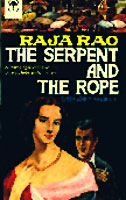 `The Serpent and the Rope` is written by Raja Rao and this is a worldly creation of the author. This can be called as a semi autobiographical story of raja Rao. The title depicts some spiritual thoughts and by this the author wants to show some truth of life. The serpent in the title refers to the illusion and the rope to the reality.
`The Serpent and the Rope` is written by Raja Rao and this is a worldly creation of the author. This can be called as a semi autobiographical story of raja Rao. The title depicts some spiritual thoughts and by this the author wants to show some truth of life. The serpent in the title refers to the illusion and the rope to the reality.
Raja Rao was an excellent writer but with this quality he was engaged in many other works. Rao`s involvement in the nationalist movement is reflected in his first two books. The novel Kanthapura published in 1938 was an account of the impact of Gandhi`s teaching on non-violent resistance against the British. The story is seen from the perspective of a small Mysore village in South India. Rao borrows the style and structure from Indian vernacular tales and folk-epic.
The story telling of the story is mesmerizing to the readers. The villager`s millennium-old worship of the local deity, the strength to stand against the British Raj is depicte din a lucid and transparent way. Rao portrays an idealist and supporter of ahimsa and Satyagraha in many of his write-ups. He wanted to show or to cross the traditional barriers of caste. The younger generation has city ways, they read city books, and they even call themselves Gandhi-men. Rao`s work was highly praised by the English writer E.M. Forster. However, Rao`s India is not a certain geographical or historical entity, but more of a philosophical concept and a symbol of spiritual calling.
Synopsis:
The Serpent and the Rope written by Raja Rao in 1960, is a story of a search for spiritual truth in Europe and India. It established him as one of the finest Indian writer and storyteller. The Serpent and the Rope was written after a long silence during which Rao lived India. During that time he renewed a connection with his roots in the modern rendering of the Mahabharata legend of Satayavan and Savithri. The work also dramatized the relationships between Indian and Western culture as well. Ramaswamy, a young Brahmin studying in France, is married to a French college teacher, Madeleine, who sees her husband above all as a guru. As Ramaswamy struggles with commitments imposed on him by his Hindu family, his wife becomes a Buddhist in her spiritual quest and renounces worldly desires after the death of their little son Pierre. She leaves her husband to find his own true self and also metaphysics of death. This leads to an inner truth of life. All human being need some space in life and the story depicts about that space. The entire concept of Karma, the twice born and eternity all are dragged into the tale. And, in this connection, he muses over Little Mother, his 26-year-old step-mother, and over his half-sister, Saroja, on whom the adoring son and brother has an Oedipal and incestuous "crush". The Serpent and the Rope has so many tangled ideas, framed like a Chinese box, a box within a box, within a box that it becomes difficult to even present a summary of Raja Rao`s palace of thought.
`The Serpent and the Rope` was published by Overlook Publisher and this is a masterpiece unfolding the natural truth of life in a extra-ordinary way by Raja Rao.
`The Serpent and the Rope` comprises of a number of layers within it. Every time one reads it, a different layer reveals itself and the mastery of the story telling craft makes it enjoyable to read. This is not a book of a story. It`s about the search for meaning and wisdom. The quest is presented by two viewpoints one Eastern, i.e. Brahminical and other Western. This book has the power to create the inclination towards literature to any normal person.



















